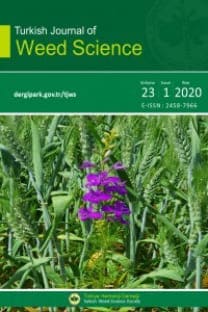Türkiye’de Tarım ve Tarım Dışı Alanlarda Görülen Küsküt Türlerinin (Cuscuta spp.) Taksonomik Özellikleri, Dağılışları ve Konukçuları
Cuscuta spp., dağılış, konukçu, taksonomik özellik
Taxonomic characteristics, distributions and hosts of dodder species (Cuscuta spp.) seen in agricultural and nonagricultural areas in Turkey
Cuscuta, distribution, host, taxonomic character,
___
- Agrios G.N. (2005) Plant Pathology,Fifth Edition, Department of Plant Pathology University of Florida, Elsevier Academic Press,USA, p. 708.
- Baytop T. (1997). Türkçe Bitki Adları Sözlüğü.(578).Türk Dil Kurumu Yayınları.
- Boissier E. (1879). Flora Orientalis. Genevae et Basileae, Lugduni, IV.
- Chrtek J, Osbornova J. (1991). Notes on the synanthropic plants of Egypt: 3. Grammica campestris and other species of family Cuscutaceae. Folia Geobot. Phytotaxin, (26): 287-314.
- Costea M, Tardif F.J. (2006). The biology of Canadian weeds. 133. Cuscuta campestris Yuncker, C. gronovii Willd. ex Schult., C. umbrosa Beyr. ex Hook., C. epithymum (L.) L. and C. epilinum Weihe. Canadian Journal of Plant Science, 86 (1): 293-316.
- Costea M, Stefanović S. (2009). Molecular phylogeny of Cuscuta californica complex Convolvulaceae and a new species from New Mexico and Trans-Pecos. Syst Bot., (34): 570-579.
- Davis P.H. (ed.) (1978). Flora of Turkey and the East Aegean Islands (Vol. 6). Edinburgh Univ. Press., Edinburgh.
- Dawson J.H, Musselman L. J, Wolswinkel P, Dörr I. (1994). Biology and control of Cuscuta. Reviews of Weed Science, (6): 265–317.
- Hadac E, Chrtek J. (1970). Notes on the taxonomy of Cuscutaceae. Folia Geobot.
- Kuijt J. (1969). The Biology of Parasitic Flowering Plants. University of California Press, Berkeley.
- Liao G.I, Chen M.Y, Kuoh C.S. (2000). Cuscuta L. (Convolvulaceae) in Taiwan. Taiwania, (45): 226-234.
- Nemli Y. (1978). Çiçekli Parazitlerden Cuscuta L.’nın Anadolu Türleri Üzerinde Morfolojik ve Sistematik Araştırmalar. Ege Üniversitesi Ziraat Fakültesi Fitopatoloji ve Zirai Botanik Kürsüsü, 108 s. İzmir.
- Nemli Y., Kaya İ, Tamer Ş.R. (2015). Cuscuta campestris. Türkiye İstilacı Bitkiler Kataloğu. Orta Karadeniz Geçit Kuşağı Tarımsal Araştırma İstasyonu Müdürlüğü. Tokat.
- Nemli Y, Öngen N. (1982). Türkiye’nin Trakya Bölgesi Küsküt Türleri (Cuscuta spp.) Üzerinde Taksonomik Çalışmalar. Doğa Bilimleri Dergisi: Vet.Hay/Tar. Orm., 6(3): 147-154.
- Parker C, Riches CR. (1993). Parasitic Weeds of the World. Biology and Control. CAB International, Wallingford. Phytotaxin, (5): 443-445.
- Yuncker T.G. (1932). The genus Cuscuta. Mem Torr Bot. Club., (18): 113-331.
- ISSN: 1303-6491
- Başlangıç: 1998
- Yayıncı: Türkiye Herboloji Derneği
İnce Delice Yoğunluğu ve Farklı Herbisit Uygulamalarının Buğday Verimi ve İnce Deliceye Etkisi
Messaad KHAMMASSI, Hanene CHAABANE, Naima BELBAHR, Thouraya SOUISSI
Ağrı İli Buğday Ekim Alanlarında Segetal Floranın Belirlenmesi
Ramazan GÜRBÜZ, Sibel UYGUR, F.nezihi UYGUR
İlhan KAYA, Yıldız NEMLİ, İbrahim DEMİR
Çeti [Prosopis farcta (Banks& Sol.) J.F.Mac.]’nin Tohum Çimlenme Biyolojisinin Araştırılması
Bahadır ŞİN, İzzet KADIOĞLU, Gamze ALTUNTAŞ, Meryem KEKEÇ, Tuğba KAZANKIRAN
Çeti [Prosopis farcta (Banks& Sol.) J.F.Mac.]’nin Tohum Çimlenme Biyolojisinin Araştırılması
Bahadır ŞİN, İzzet KADIOĞLU, Gamze ALTUNTAŞ, Meryem KEKEÇ, Tuğba KAZANKIRAN
Fırat PALA, Hüsrev MENNAN, Abdullah DEMİR
Herbisit Toksisitesi ve Yabancı Otlara Karşı Alternatif Mücadele Stratejileri
